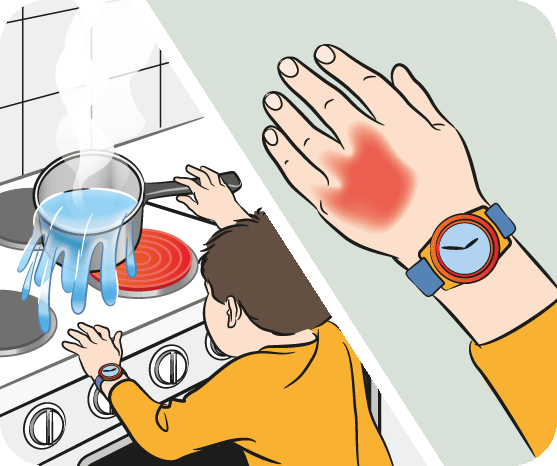Thermal burn in children: how to treat?
A child’s skin burns more easily than an adult’s. Thermal burns are caused by heat. They can be caused by hot liquids, fire, steam, or hot objects like cooking pots or pans.

Thermal burns can be quite serious
1. Thermal burn in children
Minor thermal burns damage only the top layer of skin. The skin is painful, dry, and red. Minor burns heal in less than a week. They usually don’t leave a scar. More serious burns can swell and blister. Some more serious burns heal in 1 to 3 weeks without scarring, but the skin color may permanently change.
Thermal burns are cooled with water, then carefully cleaned. The doctor may remove the damaged skin (debridement). Your child may be given acetaminophen or nonsteroidal anti-inflammatory medicines to control the pain. An antibiotic is often put on the burn. Minor burns are left open to air. More serious burns may be covered with a sterile bandage. Children with major burns or with burns around the face, genitals, hands, feet, or joints may need to stay in the hospital for treatment and observation. Or they may be transferred to a regional burn center, depending on how severe the burn is.
2. First aid for thermal burns in children
2.1. Thermal burns due to motorcycle exhaust
-
Burns are cooled with water, then carefully cleaned.
-
Wash the wound with saline, cover the burn with a special ointment, and cover it with a clean gauze.
-
Do not puncture blisters, apply unknown medications (because this will slow healing and increase the risk of infection).
-
Take your baby to a medical facility, if, during home care, there are signs of infection, such as redness or discoloration in the normal skin around the burn, the burn has a foul odor that causes pain. more, the burn is very swollen, the baby has a fever, or is accompanied by chills.
2.2. Children with fire burns, boiling water
-
Cool the burn, prevent the skin from blistering by turning on the faucet to run it slowly over the burn for about 15-20 minutes. Do not use cold water, ice (in the refrigerator) to cool the baby's skin.
-
Gently remove hard objects on the burn area such as shoes, sandals, or bracelets before the burn becomes swollen.
-
Cover the burn area with sterile gauze.
-
Comfort the child, give him water, and put him in a lying position.
-
If the burn is mild, the area of the burned skin is small, the damage can heal on its own, can be treated at home under the guidance of a doctor. If it is more severe, immediately after giving first aid, the child should be transferred to the nearest medical facility for timely treatment by doctors.

Children with fire burns, boiling water
2.3. Burns due to electric shock
-
Parents must immediately cut off the power source, use a wooden tree to remove the power cord, and pull the child away from the power source.
-
If the baby is unconscious, open the airway, and prepare CPR
-
Cool the burn by holding the injured area for at least 10 minutes under cold running water.
-
Take the child immediately to the nearest medical center for monitoring and care.
3. Caring for severe thermal burns in children
With severe burns, from grade 2 and above, causing skin ulcers, Multidex can be used to apply to the wound after it has been cleaned with physiological saline.
1. After irrigation, apply Multidex®.
a. For shallow wound – 0.6cm thick over entire wound site
b. For deep wound – fill wound site to surface taking care to fill all undermined areas
2. Cover with a non-adherent, non-occlusive dressing such as Covaderm Plus®, MultiPad™, Sofsorb®, or Polyderm™ Plus. If necessary, tape in place or use roll gauze or Stretch Net™ to secure dressing.
3. Dressing change should be once a day on minimally to moderately draining wounds and twice a day on heavily exudating wounds.
Usual frequency of dressing change is once a day, depending upon drainage and the type of secondary dressing.

Burns caused by motorcycle exhaust after 3.5 weeks of using Multidex products.